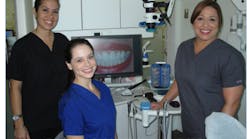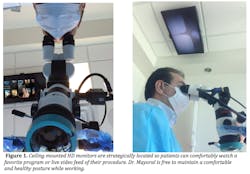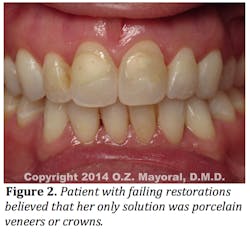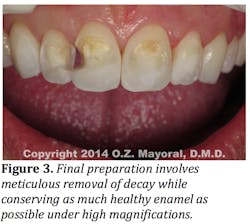Dental assistants share their experiences assisting with microscope-enhanced dentistry
Surgical microscopes have been used in operating rooms since 1953, giving surgeons the enhanced vision they need to perform with superior precision, and leaving nothing to chance. Technology is emerging very rapidly in all fields, and dentistry is no exception. About 15 years ago, clinical microscopes were introduced into dentistry as an aid in endodontics. Today, 100% of all U.S.-accredited endodontic specialty programs train their residents using microscopes exclusively.
Dentists have been wearing loupes for many years to examine patients, but it’s still the exception for dentists to perform microscope-assisted dentistry. In 2006, the dentist we assist, Dr. Osvaldo Mayoral, of Miami, Fla., began doing precision dentistry using a microscope. He now performs all dental procedures using Carl Zeiss and Global Surgical microscopes, which are specially designed to focus light as well as magnify every detail up to 20 times.
Always searching for ways to enhance the quality of his work, Dr. Mayoral was drawn to the dental microscope. This high tech piece of equipment offered both ergonomics (improved posture), and the ability to perform incredibly precise work. Although a substantial investment, this technology has been well worth it in our opinion. Not only is the technology easier on the staff’s back and shoulders, helping us stay more relaxed and focused, but patients also benefit from minimal prep, more conservative restorations (retaining more of the original tooth), and the flawless artistry that comes from working under high magnification.
Before the integration of microscope-enhanced dentistry with video, some patients didn’t appreciate the lengths we went to in order to create the most natural, esthetic restorations. They also were not able to readily see the need for restorations. Many had a tendency to put off treatment.
In our large metropolitan market where there are many choices in dental care, the use of this distinctive technology attracts patients, and quickly engages them in treatment. Now patients can see on the video exactly what the dentist sees through his microscope. As a result, they recognize and want to quickly take care of their developing problems.
Our microscopes are equipped with HD digital and video capture features. By merging magnification and live video streaming, we and our patients can clearly see the condition of the tooth structure, and see what the doctor is doing magnified five to 20 times. After a patient’s treatment, one of us invites the patient to review the microscope-enhanced video. We keep a copy of the close-up digital images and treatment video in the patient’s digital file, and can also provide patients with copies. It’s rewarding to see their delight in their newfound understanding of what’s been done for them because they can see it. We hear about them sharing their videos with friends and family. That sharing is bringing us a flow of new patients who are interested in this type of minimally invasive care.
For a while, the challenge for us as dental assistants was becoming accustomed to using the technology, and learning how to best assist in clinical setup, during operative use, and during interaction with patients. We had the added duties of educating patients about the technology, explaining what they were seeing on the video screen as it happened in real time (Figure 1), and then reviewing the video highlights after a procedure.
Our greatest challenge as dental assistants is to be one-step ahead of the doctors, knowing what they need next, and placing it in their hands at the right time. Since we watch the live HD video stream of the procedure on several monitors, we know exactly what the doctor is doing and can anticipate the next step. Therefore, since we’re more involved in the treatment, efficiency is tremendously improved. If you love dentistry like we do, there’s no better seat in the house from which to see the amazing detail of the procedures. It’s extremely rewarding for our patients and us to be part of these treatments.
It took a few months of coaching before each of us developed confidence in the instrumentation, and in our ability to provide a smooth stream of support. For some procedures, it’s advantageous to have two assistants working as a team.
Restorative work performed with microscope-enhanced dentistry is never boring. There’s always something new to learn. For example, one of our patients presented with discoloration in her upper anterior teeth due to old restorations. Instead of preparing the teeth for veneers as the patient had been told by several other dentists, we used a microscopic approach to address the diseased areas and maintain as much of her healthy dentin and enamel as possible (Figures 2,3,4) She cried with gratitude.
We’re proud to be on the leading edge of this technology and have no doubt that more dental practices will be adopting this technology in the future. Our learning process was very enjoyable, and we feel we can help other assistants make the transition in their offices nationally. It’s exciting for us as assistants to think we’re on the forefront of bringing dentistry into the 21st century.
Dr. Mayoral shares videos to demonstrate microscope dentistry to his colleagues and the public on YouTube and Google+. If you’re interested in talking to us, please reach out to us at [email protected].










